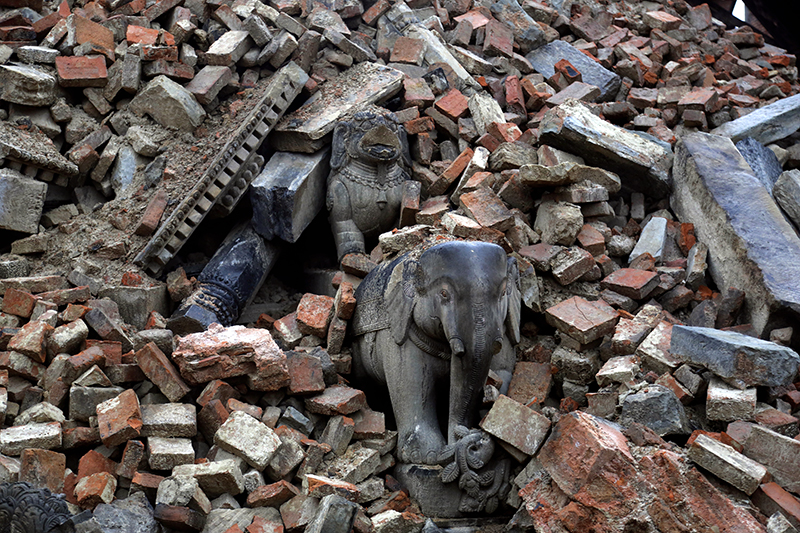Bristol engineers, local partners start SAFER project to build seismic safety in Nepal
KATHMANDU: A team of engineers from the University of Bristol and local partners in Nepal have joined hands to improve the seismic safety, and resilience of school and community buildings in our country.
After seeing the destruction made by the massive earthquake of 2015 that brought a loss of hundreds of lives, massive destruction of houses and properties, the team of SAFER (Seismic Resilience of Schools in Nepal) Nepal Project is working to prevent destruction on the same scale again.
The project is funded by the Engineering and Physical Sciences Research Council (EPSRC) as part of UK Research and Innovation’s (UKRI) Global Challenges Research Fund.
A press statement released by the University of Bristol states that the team has a multidisciplinary approach that combines the knowledge of earthquake, structural and geotechnical engineers, seismologists, earth scientists, computer scientists, social scientists, stakeholders, decision-makers from Nepal and around the world.
Professor of Earthquake Engineering at the University of Bristol and Principal Investigator of the SAFER Nepal project, Anastasios Sextos said, “We cannot prevent earthquakes from happening, but we can devise smart, low-cost solutions to mitigate seismic risk and improve our resilience to extreme events.”
“One proven method of protecting new buildings in earthquake zones in developed countries is to rest them on sliding surfaces. This can be prohibitively expensive for many regions, but in Nepal, we’re using that principle to investigate low-cost, culturally acceptable and locally-sourced ways of co-producing a similar system,” added Professor Sextos.
In order to create a low-cost seismic isolation platform, a team led by Dr Nicholas Alexander, Associate Professor of Structural Dynamics, is using the seismic shaking table at the University of Bristol to investigate how replicas of Nepali classrooms, strengthened with cost-effective techniques, perform under seismic excitation.
The team is also developing a state-of-the-art mobile application that lets local engineers to identify at-risk schools and enhance their safety.
Furthermore, it is testing the engineering properties of locally-used building materials, along with National Society for Earthquake Technology (NSET), Nepal, and Kathmandu University and Institute of Engineering, Tribhuvan University.
The project manages activities through workshops and on-site training, following this training from the project team (including Save the Children), local partners in Nepal are about to embark on a large campaign of field testing across the country.
Moreover, the project has also led the creation of first-ever database of seismic hazard in Nepal, including a unified database of the soils in Kathmandu which provides vital information and data to inform and plan building projects, as per the statement.
SAFER has also been working with Save the Children, Nepal; making surveys of around 160 school buildings and consulting with communities, focusing on school management committees, teachers and students, to understand the factors affecting resilience in order to tailor and target interventions to help children get safely back to school.
The guidelines for constructing schools in a novel, low-cost way will be delivered in September 2020 by SAFER.
“We’re essentially creating a framework that allows local decision-makers to plan for and react to another major earthquake and our collaboration will improve local design culture through new, safer, construction techniques and responses that can be easily replicated by other countries.
“Our focus has been to create tangible outcomes and influence how policy-makers approach building new schools in Nepal. Most importantly of all, we’re helping protect lives, especially the lives of the young learners who will shape Nepal’s future,” said Professor Sextos.
Dr Prachand Man Pradhan, Associate Professor and Head of the Department of Civil Engineering at Kathmandu University, said, “Collaboration between Kathmandu University and the University of Bristol has been highly productive and memorable for me."
He added, "This project has not only been able to identify the mechanical properties and strengths of various construction materials but also helped me learn the technological heights acquired by the University of Bristol. The results obtained should be ultimately useful for the earthquake resistant design and construction for new School Buildings to be constructed in Nepal.”
Likewise, Professor Prem Nath Maskey, from the Institute of Engineering at Tribhuvan University, said, “The collaboration among the universities and organizations of Nepal, UK and other countries coming together for the research project of SAFER (Seismic Resilience of Schools in Nepal) has been exemplary. The impact of the project lies in the importance of research and collaboration on the seismic resilience of schools. The impact of the project will be reflected in the necessary strengthening and reconstruction of the schools for future earthquakes and other disasters.”






